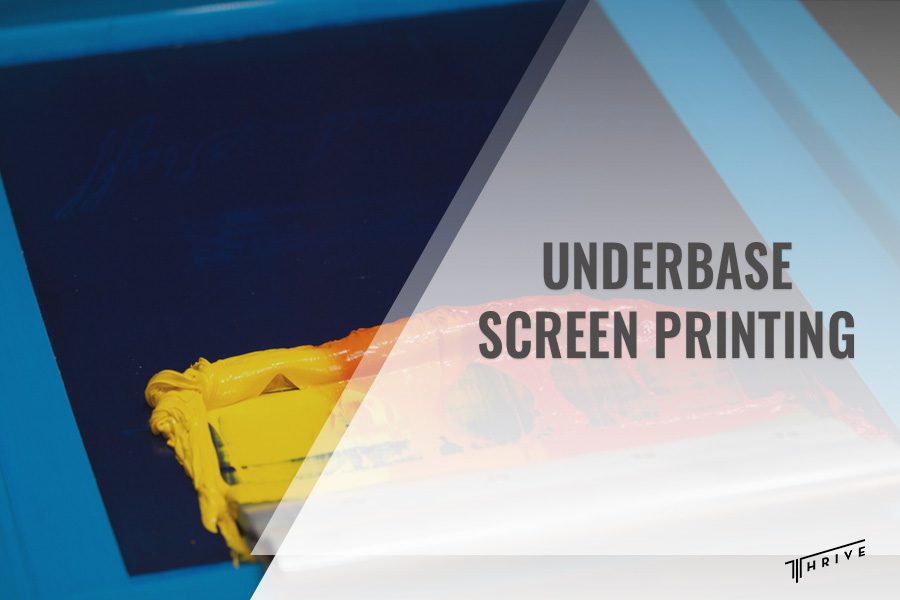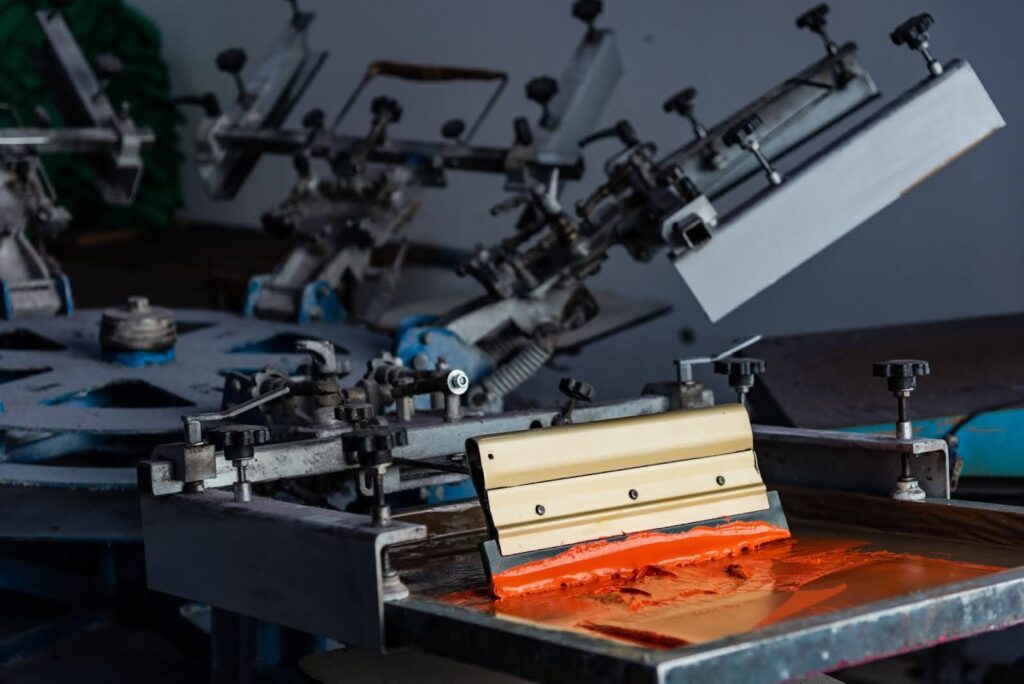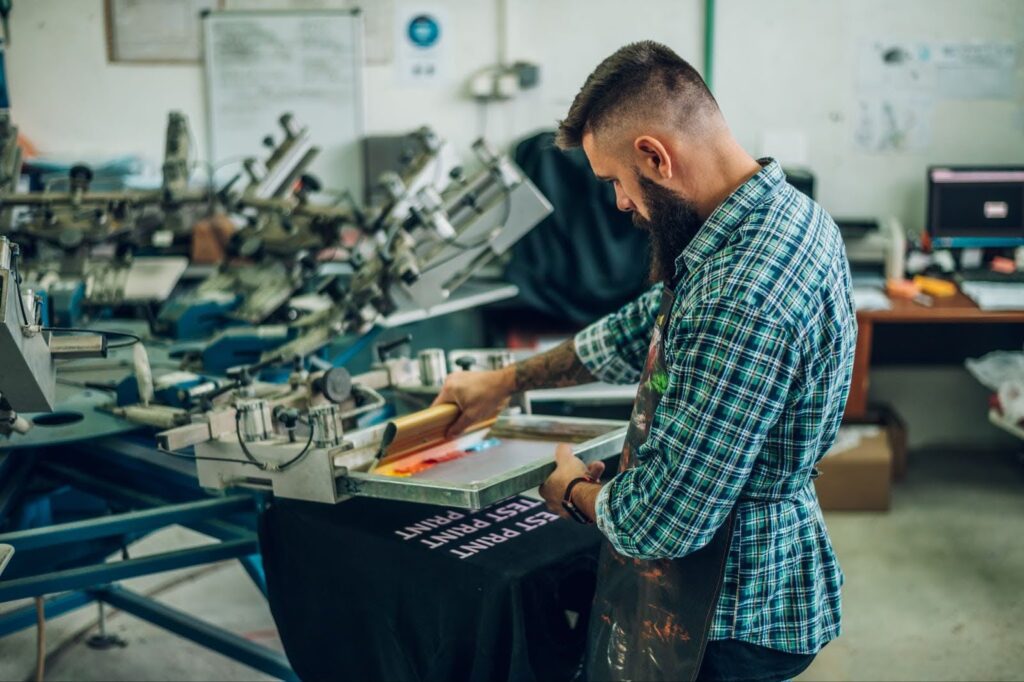
Screen printing, also known as silk screen printing or serigraphy, is a traditional printing method of reproducing intricate prints through a meticulous process of pushing ink through a stenciled mesh placed above a garment. This extremely versatile technique has been a cornerstone in the printing industry, renowned for its ability to produce exceedingly vibrant and long-lasting images. However, one critical step in screen printing is taking center stage in delivering unparalleled brilliance in colors – underbasing. But what is underbase screen printing, and why do you need it?
In this article, we’ll explore the definition of an underbase in screen printing and how it works. Additionally, discover some tips and tricks we use to get the ultimate foundations for your prints.
What Is Underbase in Screen Printing?
So, what is an underbase in screen printing?
An underbase in screen printing, also called an underlay or a mask, refers to a foundational layer that enhances the vibrancy and vividness of printed designs. This is a critical step when printing on black or darker-colored fabric, which can impact the clarity and visibility of the printed colors.
Essentially, the underbase is a layer of white or other light-colored ink that is strategically applied before any other colors, creating a solid foundation and covering the whole printing area. It acts as the “base” or blank canvas for the other colors to sit on, giving them more brilliance and an intense look. The underbase will maintain the integrity and accuracy of the colors. Generally, underbases serve three main purposes in creating a foundation:
- To prevent the fabric color from blending through the printed design
- To create a reflective enough surface, which makes the top colors appear brighter and more saturated
- To block the garment’s color and the material’s individual fibers

How underbase screen printing works?
Printing with an underbase isn’t quite as simple and straightforward as it seems. This specialty screen printing requires a lot more than putting down a layer of white ink in the shape of your design.
Screen printing is a method that involves creating a separate stencil for each color of the design on a mesh screen. These stencils are then carefully placed over the fabric to be printed, with ink pressed through the open areas onto the surface. However, the addition of an underbase can change the whole outcome of the final result, making the colors pop up and deliver a more vibrant look.
In order to achieve a proper underbase, the garment must be flash-cured before printing the additional colors from the design on top of it. This means that you would need a press with enough print heads to accommodate the underbase, flash curing, as well as extra colors.
This method of printing an underbase may be slower and more time-consuming compared to jobs without flash curing, but the result prints are unparalleled. Keep this in mind when planning the turnaround time for your next project.
Tips for Printing an Underbase in Screen Printing
When exploring the underbase technique in screen printing, you may be asking several questions. One of the most common ones is do you need underbase for plastisol?
In screen printing, you’ll find a myriad of specialized inks and pigments used for a variety of purposes. Plastisol inks are one of the more common in the printing industry, made from PVC–polyvinyl chloride and plasticizers. This makes the inks a lot thicker and more opaque than water-based inks.
Although special high-opacity plastisol pigments are commonly used for vibrant prints, they could be quite expensive and difficult to print. They might also give your prints a heavy hand that may be uncomfortable to wear. So, what is the alternative?
The alternative is printing an underbase. Here are some tips for printing an underbase that helps provide the ultimate foundation for any design.
1. How to get a good foundation
Screen printing white underbase requires a good amount of experience and precision to achieve the desired results. When executing this stage, it’s important to use minimal amounts of ink to achieve a soft feel while also providing a solid base for the other colors.
The mesh count plays a critical role in the smoothness of the underbase. The lower the mesh count, the smoother the texture. However, it’s important not to overdo it as it can end up creating a rough texture for the top colors, compromising the overall quality of the final print. The right mesh count varies depending on the printing press and inks, but typically, starting with 125-150 is recommended for spot color designs and 200+ for fine details or halftones.
Moreover, if your design includes whites, it’s best to use separate whites for the base and top colors. Using a white highlight color for the underbase may result in a thick layer of ink as it uses too much pigment, making it difficult to cure. Splitting the whites ensures better color quality and overall appeal.
2. Keeping tight registration is key to quality
Achieving tight registration in screen printing underbase is vital for the quality of your prints. It’s the key to printing a professional foundation.
The underbase shouldn’t be visible in the final prints unless it specifically requires white outlines. In order to ensure this, the underbase prints should be slightly skinnier than the top color layers, which will result in something called a “choke”. It would help if you have a quality, professional-grade screen printing machine to properly align the underbase and top colors, keeping the foundation inside the boundaries of the top layer inks.
However, these machines can be quite expensive, so aiming to get the right technique, proper equipment, and well-tensioned screens can get you brilliant plastisol prints even on the darkest garments. At Thrive Screen Printing, we understand that screen printing can be tricky, and the equipment may be unavailable for a number of reasons. That’s why we offer you contract printing services using the latest equipment and technology, which makes getting great results easier than ever.
3. Proper printing technique and setup
Of course, proper techniques are vital in any printing project you indulge in, and printing an underbase is no exception. As the underbase should be slightly skinnier than the top colors, one key aspect is adjusting the press off-contact. This will ensure the thicker underbase clears the screen smoothly and cleanly.
To get a seamless print, it’s best to use a slow stroke to let the ink flow properly. Using a slightly dulled squeegee may also help to achieve a smooth print. Equally important is ensuring the ink is completely clean out of the screen. Leaving ink in the image area after the print stroke will create an uneven foundation for the top colors, compromising the overall quality.
Smooth underbases enhance the overall quality and vibrancy of top colors, while any irregularities like peaks or stringing of the underbase can hinder the coverage of the top color printing. When printing on soft-surface t-shirts or hoodies where an uneven underbase is most common, achieving a smooth foundation and using proper printing techniques become essential.

Conclusion
So, what is underbase in screen printing t-shirts?
In conclusion, an underbase is the foundational layer responsible for enhancing the vibrancy and vividness of the top colors of printed designs. Its primary role in ensuring optimal coverage and color consistency cannot be overlooked in screen printing.
A well-executed underbase is critical for anyone looking to achieve the opaque and vibrant effect of plastisol inks without breaking the bank for these expensive pigments. With our provided tips, achieving uniform underbases for exceptional and professional prints on even the darkest clothes becomes easier than ever.
Hopefully, our article has helped you gain a better understanding of underbase screen printing and how a simple layer of foundation can enhance the overall appeal and color quality of your prints.

Robert Fisher is the founder and CEO of Thrive Screen Printing and brings extensive experience in the screen printing and fulfillment industry.

